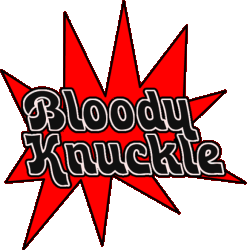 TM TM
 Circa 1965-1966 style fuzz
A modified and improved version of the oldest fuzz circuit I
know of
The Skreddy Pedals™ Bloody Knuckle is an ALL GERMANIUM
3-transistor fuzz.
The original Maestro™ Fuzz Tone was made famous with
the Rolling Stones' hit "Satisfaction." Then the first version of the
Tone Bender was made by Gary Hurst, basically a direct copy, only using
different transistors and a few different resistor values, ostensibly to
give it more sustain. (also a bit less of an angry bees in a jar
thing)
What I've done is...
-
...Take that same old design and improve
the "Attack" control such that it has a gradual sweep and is very useful all
the way from top to bottom
-
...Fix the bias, BUT JUST BARELY, so it
has plenty of sustain and does not have a gated (on or off) effect.
Instead what it does is it breathes and sags, kind of like a weak tube
rectifier in an old amp. You can defeat the sag effect by simply
turning down the Attack control a bit or by adding some neck pickup.
It sags the most with the bridge pickup when droning some low E and playing
power riffs on the A string--you can make it almost choke out using this
technique. Fun stuff!
-
...Improve the sound quality. The
Maestro Fuzz Tone utilized a 100k resistor at the input of the effect,
resulting in a weak, low-fi signal. On the other hand the Tone Bender
Mk1 used a 2 megaohm resistor at its output to pad the volume down, again
resulting in a low-fi signal. I am using 100 ohms in series at input
(just enough to soften the attack a tiny bit and warm it up) and zero ohms
in series with the output (other than the volume pot). I am instead
padding the output signal with a voltage divider, the same way the Fuzz Face
design does, giving a clear, well-defined sound.
|
|
|
Familiar,
slightly sick, slightly splatty, a bit of a sluggish attack, but
still fairly straightforward and ultimately satisfying & addictive fuzz tones
Controls...
Level:
Gives a healthy amount of volume unlike some originals
Attack:
Useful range from top to bottom, from spitting, sustaining,
saggy fuzz to robust, full-bodied distortion to grungy,
under-powered dirt
|
The two songs that inspired me to make this
pedal were "What is Life" by George Harrison (the opening fuzz tone
riff) and the rhythm guitar in the song "Baby Blue" by Badfinger.
You can get the former fuzz tone effect by turning up the Attack control all
the way, and you can get the latter grungy rhythm tone by turning it down
a great deal. Also does a lot of Zeppelin type fuzz tones.
This pedal works best when driven by a strong
pickup like a humbucker. But, you do not want to run active pickups
into it, nor have a boost of any kind in front of it. Works great after wah
pedals, though! (remember Mick Ronson)
Does a nice liquid/"woman" tone using the neck pickup
playing leads on high frets, too. It's not all about fizz and spit
and glitchiness. There is still a fair amount of your guitar's actual
sound coming through!
|
US orders will be sent via USPS Priority Mail (signature
required).
International orders will be sent USPS Global Priority (where
available).
We will not declare your package at a lower value for customs;
be prepared to pay your country's import duty when you receive
the package.
|
|
Power
It uses typical, normal 9v negative-ground; no special power
requirements at all.
9v battery is not included.
If you use a battery, then remember to un-plug the input cable
from the pedal’s input jack when not in use to prevent draining (or you
can also just plug in a power-supply, which disconnects the battery).
You may supply external power through an AC adapter. All Skreddy
Pedals accept the industry-standard 9v DC plug (5.5mm barrel x 2.1mm
center coax), negative tip. Please use a quality, regulated,
filtered power supply.
|
 TM
TM

